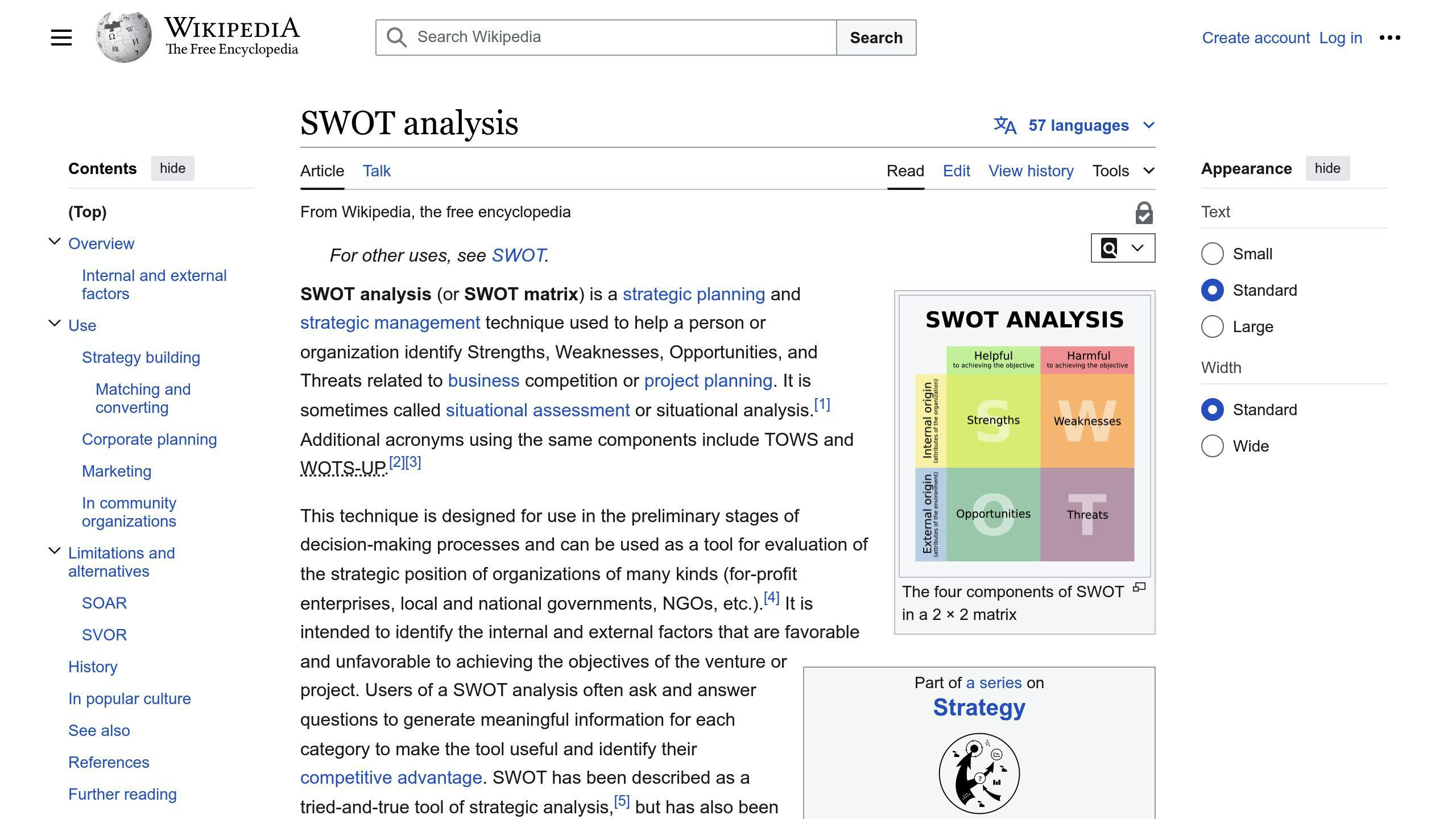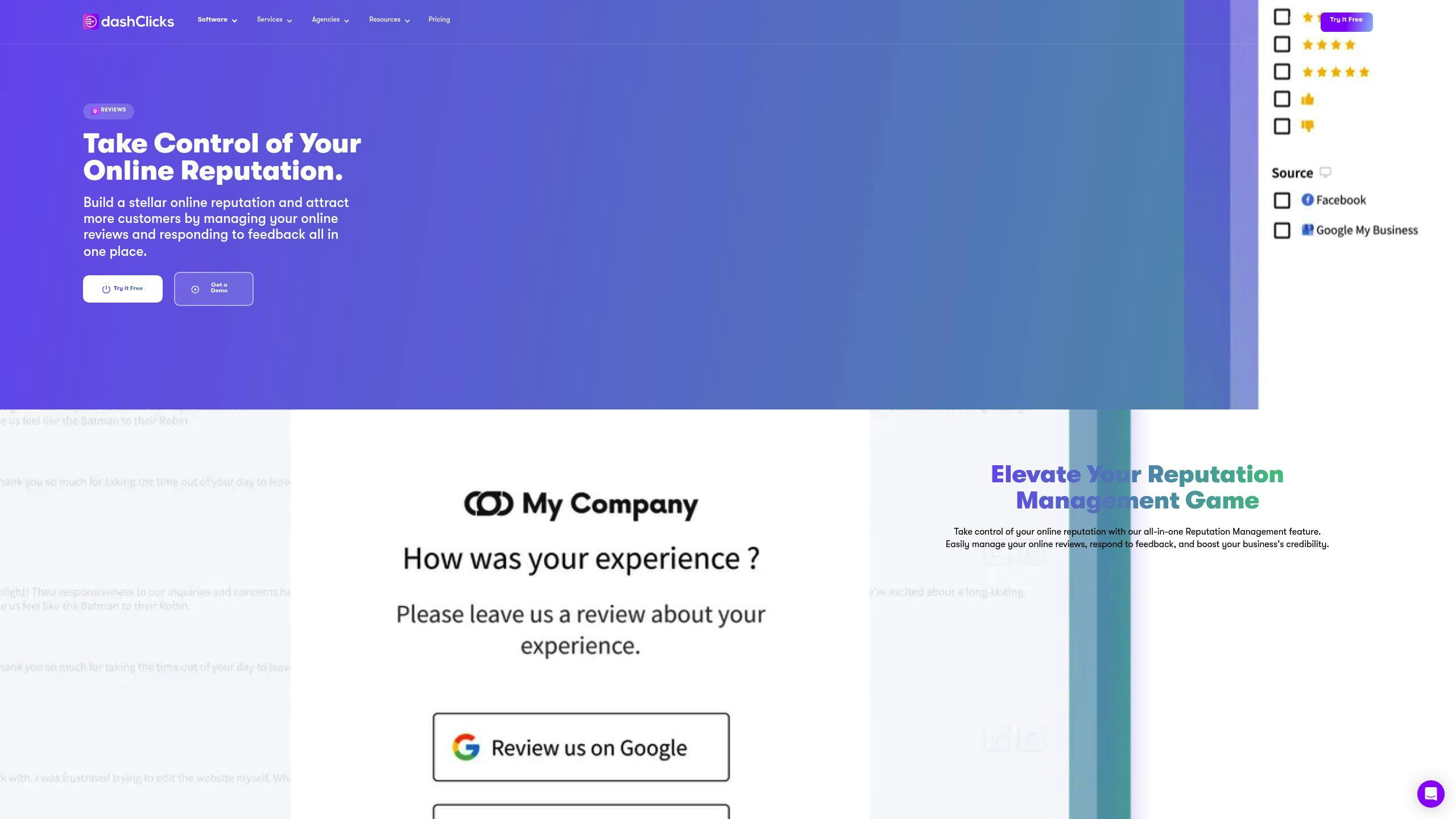Here's a quick guide to creating an effective marketing plan:
- Assess your current situation (SWOT analysis)
- Define your target audience
- Set clear, measurable goals
- Identify your unique selling proposition
- Choose marketing channels
- Allocate your budget
- Create content and social media plans
- Manage customer reviews
- Break down tasks into actionable steps
- Track and measure results
Key benefits:
- Keeps you focused on goals
- Helps manage resources wisely
- Allows you to track progress
- Enables quick adaptation
| Step | Purpose | Example |
|---|---|---|
| Set goals | Define targets | Increase website traffic by 50% in 6 months |
| Know audience | Target effectively | Create customer profiles with demographics and interests |
| Choose channels | Reach customers | Social media, email marketing, content marketing |
| Allocate budget | Maximize ROI | 30% social media, 25% content, 20% email, 15% ads |
| Track results | Measure success | Monitor website visits, leads, and sales weekly |
Remember: Start simple, focus on what works for your business, and adjust as you learn.
Look at Your Business Now
To create a simple marketing plan, you need to understand where your business stands. Let's break it down:
Do a SWOT Check

SWOT analysis is your friend here. It stands for Strengths, Weaknesses, Opportunities, and Threats. Here's a quick way to do it:
- Gather your team
- List your strengths
- Note your weaknesses
- Spot opportunities
- Identify threats
Use this grid to organize your thoughts:
| Strengths | Weaknesses | Opportunities | Threats |
|---|---|---|---|
| Top-notch products | Old equipment | New markets | Rising costs |
| Loyal customers | Small marketing budget | Online expansion | More competitors |
Check Out Your Rivals
Know your competition. It's that simple. Here's how:
- Google businesses like yours
- Visit their websites and social media
- Note their strengths and weaknesses
- See how they talk to customers
For example, if you're a baker, check out other local bakeries' prices, products, and customer service.
Review Your Current Marketing
Take a hard look at what you're doing now:
- What marketing methods are you using?
- How much are you spending?
- What results are you getting?
Track your efforts like this:
| Marketing Method | Monthly Cost | Results (New Customers) |
|---|---|---|
| Social media ads | $500 | 50 |
| Email newsletter | $100 | 30 |
| Local events | $200 | 20 |
This review shows you what's working and what's not. Use it to focus your new marketing plan.
2. Know Your Customers
To create an effective marketing plan, you need to understand your target audience. Here's how:
Customer Basics
Start with key customer info:
| Trait | Examples |
|---|---|
| Age | 25-34, 35-44, 45-54 |
| Gender | Male, Female, Non-binary |
| Income | $30k-50k, $50k-75k, $75k+ |
| Location | Urban, Suburban, Rural |
| Education | High School, Bachelor's, Master's |
This data helps you segment your audience and tailor your marketing.
Dig Deeper
Go beyond demographics. Learn about your customers' lives:
- Hobbies and interests
- Pain points
- Shopping habits
- Brand preferences
For example, eco-friendly product customers might be environmentally conscious, prefer organic food, and support sustainable brands.
Create Customer Profiles
Use your insights to build detailed customer personas. Here's an example:
Sarah:
- 32-year-old city dweller
- Graphic designer
- Yoga enthusiast and health-conscious
- Online shopper
- Supports small businesses
This profile helps you visualize how to reach Sarah and similar customers.
How to Get Customer Insights
- Run surveys
- Analyze your sales data
- Talk to your sales team
- Monitor social media conversations
Knowing your customers helps you:
- Develop products they want
- Craft compelling messages
- Choose effective marketing channels
- Improve customer service
Remember: The better you know your customers, the more successful your marketing will be.
3. Set Clear Marketing Goals
Setting clear marketing goals is crucial for your business plan. Here's how:
Make SMART Goals
SMART goals focus your efforts and track progress:
- Specific
- Measurable
- Achievable
- Relevant
- Timed
Instead of "increase website traffic", try:
"Boost monthly website visitors from 10,000 to 15,000 by December 31st through weekly blog posts and social media promotion."
Align Goals with Business Growth
Your marketing goals should support your business goals. Here's the process:
1. Review your business plan
What are your main business goals? Examples:
- 20% sales increase
- New product launch
- New market entry
2. Create matching marketing goals
Set 1-2 marketing goals for each business goal.
| Business Goal | Marketing Goal |
|---|---|
| 20% sales increase | 30% more qualified leads |
| New product launch | 1,000 pre-orders |
| New market entry | 5,000 social media followers in target area |
3. Choose clear metrics
Use tools like Google Analytics or your CRM to track progress.
4. Review and adjust
Check goals monthly. Falling behind? Tweak your tactics. Ahead? Aim higher.
"Marketing goals should always align with your long-term business goals." - New Path Digital
Remember: Push for growth, but keep it realistic. Be honest about your team's capacity.
4. Find What Makes You Special
Want to stand out? You need to know what makes your business unique. Here's how:
Write a Clear Message
Your message should tell customers why you're the best choice. Fast.
- List what makes you different
- Check out your competitors
- Know what your customers want
- Mix it all into one catchy line
Think FedEx: "When it absolutely, positively has to be there overnight." Boom. Fast and reliable.
Show Why You're Different
You can stand out in six ways:
- Product
- Service
- Distribution
- Relationships
- Reputation
- Price
Pick what you're best at. McDonald's? They're all about consistent service everywhere.
To find your edge:
- Ask loyal clients why they stick with you
- Note the best compliments you've gotten
- Spot what you do well that others don't
Small businesses can shine by:
- Getting personal with customers
- Showing strong values
- Using local know-how
- Jumping into community stuff
Hiut Denim Co. only makes jeans. Their message? "Do one thing well." Simple and clear.
Patagonia goes with "We're in business to save our home planet." Eco-friendly folks love it.
| How to Stand Out | Who Does It Well |
|---|---|
| Product | Bee's Wrap: "A Simple Solution to Plastic Pollution" |
| Service | Stripe: "Financial infrastructure for the internet" |
| Price | Robinhood: "Make your money do the most" |
| Values | TOMS: "Shoes for Moving Forward" |
5. Pick Your Marketing Methods
Choosing the right marketing methods can make or break your plan. Let's dive in:
Online Marketing
Online marketing helps you reach tons of people without breaking the bank:
- Social media: Go where your customers are. If you're B2C, Facebook's a good bet - nearly 60% of U.S. adults use it regularly.
- Email marketing: Keep in touch with customers and leads.
- SEO: Help people find you online.
- Online ads: PPC ads can put you in front of potential customers fast.
Traditional Marketing
Don't write off old-school methods:
- Print ads: Local papers or magazines can work for community reach.
- Networking: Hit up local events or join business groups.
- Direct mail: Send flyers to potential customers nearby.
Match Methods to Your Customers
Pick marketing tactics based on your customers' habits. Here's a quick comparison:
| Method | Best For | Real-World Example |
|---|---|---|
| Social Media | Visual products, younger audiences | Andytown Coffee Roasters teamed up with a local filmmaker for indie theater ads |
| Repeat customers, complex products | Back Cove Personal Fitness gave free, quality T-shirts to clients, boosting word-of-mouth | |
| SEO | Problem-solving businesses | A handcraft business found success with Pinterest, not Google or Etsy ads |
| Print Ads | Local or older-audience targeting | Terrance Osborne Gallery gave free prints to local frame shops, leading to ongoing sales |
| Events | Face-to-face interaction businesses | Moonshot Coffee hosted a "Guest Appreciation Day" with freebies to build loyalty |
Don't try to do it all. Start with one or two methods that fit your business and customers. Test, learn, and adjust.
"Marketing is meant to raise brand awareness and build a pipeline of qualified leads that turn into sales."
This quote nails it. Your marketing choices should help people know you exist and eventually become customers.
6. Plan Your Marketing Money
Splitting your marketing budget wisely is crucial. Here's how:
Smart Budget Allocation
Divide your budget based on your business priorities. A general guide:
| Revenue | Marketing Budget (7-8%) |
|---|---|
| $200,000 | $14,000 - $16,000 |
| $500,000 | $35,000 - $40,000 |
| $1,000,000 | $70,000 - $80,000 |
But these numbers vary by industry:
- Tech: up to 21% of revenue
- Healthcare: typically 18%
- Retail: usually 14%
Look at your past marketing efforts. What worked? Use that to guide your spending.
A small tech startup might split their budget like this:
- 40% digital ads
- 30% content marketing
- 20% SEO
- 10% email marketing
Balance Time and Money
Consider both cash and time costs. Some methods are cheap but time-consuming, others cost more but save time.
Typical monthly costs:
- SEO: $500-$20,000
- Social media marketing: $250-$10,000
- Email marketing: $300-$2,500
These don't include your team's time investment.
"Smart business owners should find ways to manage and grow their marketing budgets without setting arbitrary minimums or ceilings on their spend." - U.S. Small Business Administration
Rule of thumb: Set aside 7-8% of revenue for marketing if you're making less than $5 million yearly. Adjust based on goals:
- Steady growth: 3-5% of revenue
- Moderate growth: 7-9%
- Rapid scaling: 12% or more
Pro tip: Save about 15% of your marketing budget for experimenting. It helps you find new ways to reach customers without breaking the bank.
sbb-itb-0fc0b25
7. Make Your Marketing Plans
Time to create your marketing plans. Let's focus on four key areas:
Plan Your Content
Content marketing attracts and keeps customers. Here's how:
- Set goals (more website visits, email sign-ups)
- Know your audience
- Choose content types (blogs, videos, podcasts)
- Make a content calendar
- Plan to measure results
"Content marketing must be relevant and consistent. It's about attracting and engaging a target audience with useful information or entertainment." - Mischa McInerney, CMO, Digital Marketing Institute
Plan Your Social Media
Social media connects you directly with customers:
- Pick 2-3 platforms your customers use
- Decide posting frequency
- Plan content mix (original, shared, promotional)
- Set up a posting schedule
- Plan to engage followers
| Content Type | Percentage |
|---|---|
| Original | 60% |
| Shared | 30% |
| Promotional | 10% |
Plan Your Emails
Email marketing can boost your ROI. Here's the plan:
- Build your email list
- Choose email types (newsletters, promos, updates)
- Set a sending schedule
- Plan your content
- Test and improve
Fun fact: Email marketing can increase sales by 20% compared to cold leads.
Plan Your SEO
SEO helps people find you online:
- Research keywords
- Optimize website content
- Improve technical SEO
- Build quality backlinks
- Track rankings and traffic
8. Manage Customer Reviews
Online reviews can make or break your business. Here's how to handle them:
Use ReputationDash

ReputationDash helps you manage customer feedback across platforms:
- Real-time alerts for new reviews
- Central dashboard to track all reviews
- Tools to respond quickly
Answer Feedback
Responding to reviews shows you care. Here's how:
- Answer within a week (53% of customers expect this)
- Thank reviewers
- Address issues in negative reviews
- Invite further conversation
"Responding to reviews shows that you value customer feedback, which helps build trust with both current and potential customers." - GoSite
Use Good Reviews in Marketing
Happy customers are your best advertisers:
- Add top reviews to your website
- Share positive feedback on social media
- Include customer quotes in email campaigns
| Where to Use Reviews | Why It Works |
|---|---|
| Landing pages | Boosts credibility |
| Near CTAs | Reinforces offers |
| In blog posts | Attracts attention |
| Google Business Profile | Improves local SEO |
9. Make a To-Do List
Want to turn your marketing plan into action? Break it down into tasks you can actually do. Here's how:
Bite-sized Tasks
Don't write "Run a social media campaign." Instead, list out:
- Pick a hashtag
- Make 5 Instagram posts
- Write 10 tweets
- Schedule this week's posts
Suddenly, your big plan doesn't seem so scary.
Who Does What (and When)
Give each task an owner and a deadline:
| Task | Owner | Due Date |
|---|---|---|
| Design logo | Sarah | May 15 |
| Write product descriptions | Tom | May 20 |
| Set up Google Analytics | Alex | May 25 |
This keeps everyone on their toes and your plan moving forward.
Put It on a Timeline
Map out your tasks:
- Use a spreadsheet or a tool like GanttPRO
- Prioritize your list
- Add start and end dates
- Mark big moments as milestones
"Split your plan into two-week chunks. It helps you focus on what's important right now."
Check your progress every two weeks. This way, you can fix things before they go off track.
10. Check How You're Doing
Time to see if your marketing plan is working. Here's how:
Pick Your Metrics
Choose about 5 key numbers to track:
- Website traffic
- Social media followers
- Email open rates
- Sales from campaigns
Set Up Tracking
Use these tools:
- Google Analytics: Free. Shows where visitors come from and what they do.
- Cyfe: Free and paid ($29 - $89+ monthly). Build custom dashboards for multiple metrics.
Keep an Eye on Progress
Check your numbers:
- Weekly for quick wins
- Monthly for deeper dives
- Quarterly for big changes
Track progress like this:
| Metric | Goal | Week 1 | Week 2 | Week 3 | Week 4 |
|---|---|---|---|---|---|
| Website Visits | 1000 | 850 | 920 | 980 | 1050 |
| New Leads | 50 | 30 | 40 | 45 | 55 |
| Social Shares | 100 | 70 | 85 | 95 | 110 |
This table helps spot trends and hit targets.
The goal? Improve. If something's not working, change it. If it is, do more.
"If you don't measure it, you can't improve it." - AppSumo Blog
Wrap-Up
Plans Matter
A solid marketing plan is your roadmap to growth. It's not just a document - it's your business GPS. Here's the deal:
- It keeps you FOCUSED on what matters
- You'll waste less cash on useless marketing
- You can actually see what's working (and what's not)
Get this: businesses with a clear digital marketing plan grow 60% faster than those winging it. That's huge.
Always Be Learning
Marketing never stands still. Neither should you. Here's how to stay sharp:
- Keep your finger on the pulse of new trends
- If something's not clicking, pivot
- Let data drive your decisions
| Action | Frequency | Purpose |
|---|---|---|
| Result check | Weekly | Quick wins |
| Plan update | Monthly | Stay on course |
| Skill boost | Quarterly | Level up |
As HubSpot's CEO Brian Halligan puts it: "It's not what you sell that matters as much as how you sell it!"
FAQs
How do I write a marketing plan for a small business?
Writing a marketing plan for a small business is simpler than you might think. Here's how:
1. Set clear goals
Pick specific targets like:
- 50% more website traffic in 6 months
- 1,000 new social media followers in 3 months
- 500 more email subscribers in 4 months
2. Know your audience
Create customer profiles with:
- Basic info (age, location, income)
- Interests and pain points
- Buying habits
3. Describe what you offer
Focus on how your products or services solve problems.
4. Check out competitors
| Competitor | Strengths | Weaknesses | Your Edge |
|---|---|---|---|
| Company A | Low prices | Poor service | Better quality |
| Company B | Big brand | Limited options | More personalized |
5. Find your unique angle
What makes you stand out? Maybe it's:
- Fastest delivery
- Only organic ingredients
- 24/7 support
6. Set your budget
Divide your money across channels:
| Channel | % of Budget | Amount |
|---|---|---|
| Social media | 30% | $300 |
| Content marketing | 25% | $250 |
| Email marketing | 20% | $200 |
| Paid ads | 15% | $150 |
| Other | 10% | $100 |
7. Plan your actions
For example:
- 3 social media posts weekly
- 2 blog posts monthly
- Weekly email newsletter
8. Track and tweak
Keep an eye on visits, leads, and sales. Adjust based on what's working.


